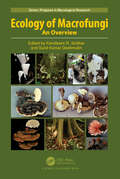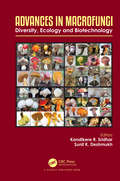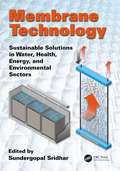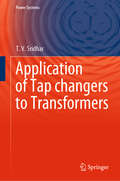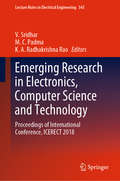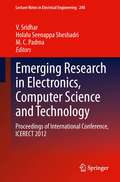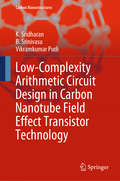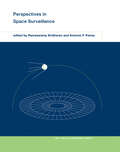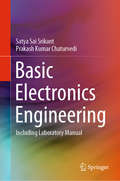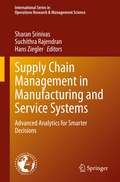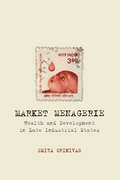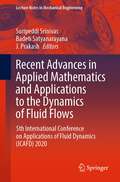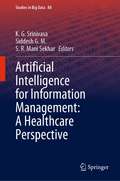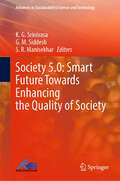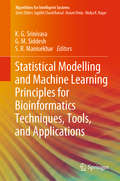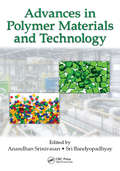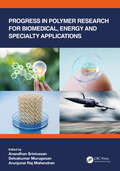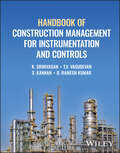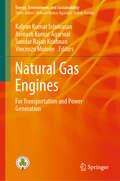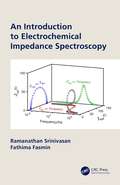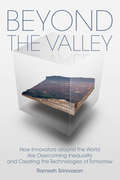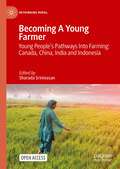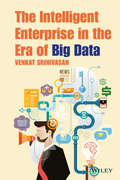- Table View
- List View
Ecology of Macrofungi: An Overview (Progress in Mycological Research)
by Kandikere R. Sridhar Sunil Kumar DeshmukhMacrofungi have significant importance in human health, particularly in nutrition, medicine, pharmaceuticals, agriculture and industries. They occupy a variety of ecosystems such as terrestrial (agricultural lands, forests and deserts), freshwater (bogs and marshes) and maritime (mangroves and coastal sand dunes) habitats. Their ecosystem services like nutrition (humans and animals), medicinal pursuits (antibiotics and pharmaceuticals) and bioremediation (degradation of xenobiotics and insect control) potential are dependent on their diversity and ecological conditions. Macrofungal ecology serves as the basis for nutraceutical values, agricultural benefits, plant productivity, environmental protection and industrially valued biocomposites. This book focuses on various aspects of macrofungal distribution in diverse habitats, participation in organic matter decomposition, ectomycorrhizal associations and participation in biogeochemical cycles. This book reviews the current developments in macrofungal ecology in different habitats and their benefits. Due to the topics dealt with on macrofungal diversity, distribution, dynamics, lifestyles, ecosystem or substrate preferences and ecosystem services, this book is valuable to mycologists, botanists, zoologists, ecologists, foresters, geneticists, agronomists and field biologists.
Advances in Macrofungi: Diversity, Ecology and Biotechnology
by Kandikere Ramaiah Sridhar Sunil Kumar DeshmukhAdvances in Macrofungi: Diversity, Ecology and Biotechnology discusses the diversity and ecology of edible, toxic, medicinal and mycorrhizal macrofungi; the impact of ectomycorrhizal fungi in terrestrial ecosystems, ectomycorrhizal complex in Boreal forests and commercial application of Pseudotsuga in silviculture; the nutritional evaluation and cultivation of edible wild mushrooms; the diversity of novel metabolites of macrofungi useful in food, pharmaceutical and cosmeceutical industries; mushrooms as tool for eco-friendly synthesis of nanoparticles and proteomics of edible and medicinal mushrooms. In addition, it covers experimental designs, methodological approaches, biogeochemical cycles, conceptual/hypothetical models and life history strategies, linking mycorrhizal diversity to plant performance, chemotaxonomy, role of mycorrhizae in forestry and macrofungi in nanotechnology. It provides a valuable resource to graduate, post-graduate and researchers (in botany, microbiology, ecology, biotechnology, forestry, life sciences and environmental sciences) to understand the diversity, ecology, therapeutic value, mutualistic associations and biotechnological potential of macrofungi.
Membrane Technology: Sustainable Solutions in Water, Health, Energy and Environmental Sectors
by Sundergopal SridharContributed by multiple experts, the book covers the scientific and engineering aspects of membrane processes and systems. It aims to cover basic concepts of novel membrane processes including membrane bioreactors, microbial fuel cell, forward osmosis, electro-dialysis and membrane contactors. Maintains a pragmatic approach involving design, operation and cost analysis of pilot plants as well as scaled-up counterparts
Application of Tap changers to Transformers (Power Systems)
by T. V. SridharThis book focuses on the role and application of tap changers to power transformers and the power transmission industry in general. Starting with an elementary introduction to the fundamentals of tap changers, the book discusses the evolution of resistance tap changers and their current applications. It also includes the most recent technologies in the field like the vacuum and reactor tap changers, and discusses the driving mechanisms, operations and maintenance. This book can be a very useful reference for power systems professionals, engineering consultants, transformer manufacturers, and R&D organizations in the specification, installation, operation and maintenance of tap changers.
Emerging Research in Electronics, Computer Science and Technology: Proceedings Of International Conference, Icerect 2012 (Lecture Notes in Electrical Engineering #248)
by V. Sridhar M. C. Padma K. A. Radhakrishna RaoThis book presents the proceedings of the International Conference on Emerging Research in Electronics, Computer Science and Technology (ICERECT) organized by PES College of Engineering in Mandya. Featuring cutting-edge, peer-reviewed articles from the field of electronics, computer science and technology, it is a valuable resource for members of the scientific research community.
Emerging Research in Electronics, Computer Science and Technology
by V Sridhar Holalu Seenappa Sheshadri M C PadmaPES College of Engineering is organizing an International Conference on Emerging Research in Electronics, Computer Science and Technology (ICERECT-12) in Mandya and merging the event with Golden Jubilee of the Institute. The Proceedings of the Conference presents high quality, peer reviewed articles from the field of Electronics, Computer Science and Technology. The book is a compilation of research papers from the cutting-edge technologies and it is targeted towards the scientific community actively involved in research activities.
Low-Complexity Arithmetic Circuit Design in Carbon Nanotube Field Effect Transistor Technology (Carbon Nanostructures)
by K. Sridharan B. Srinivasu Vikramkumar PudiThis book introduces readers to the emerging carbon nanotube field-effect transistor (CNTFET) technology, and examines the problem of designing efficient arithmetic circuits in CNTFET technology. Observing that CNTFETs make it possible to achieve two distinct threshold voltages merely by altering the diameter of the carbon nanotube used, the book begins by discussing the design of basic ternary logic elements. It then examines efficient CNTFET-based design of single and multiple ternary digit adders by judicious choice of unary operators in ternary logic, as well as the design of a ternary multiplier in CNTFET technology, and presents detailed simulation results in HSPICE. Lastly, the book outlines a procedure for automating the synthesis process and provides sample code in Python.
Perspectives in Space Surveillance (MIT Lincoln Laboratory Series)
by Ramaswamy Sridharan Antonio PensaThe development of deep space surveillance technology and its later application to near-Earth surveillance, covering work at Lincoln Laboratory from 1970 to 2000.In the 1950s, the United States and the Soviet Union raced to develop space-based intelligence gathering capability. The Soviets succeeded first, with SPUTNIK I in 1957. The United States began to monitor the growing Soviet space presence by developing technology for the detection and tracking of man-made resident space objects (RSOs) in near-Earth orbit. In 1972, the Soviet Union launched a satellite into deep space orbit, and the U.S. government called on MIT Lincoln Laboratory to develop deep space surveillance technology. This book describes these developments, as well as the later application of deep space surveillance technology to near-Earth surveillance, covering work at Lincoln Laboratory on space surveillance from 1970 to 2000.The contributors, all key participants in developing these technologies, discuss topics that include narrow beam, narrow bandwidth radar for deep surveillance; wide bandwidth radar for RSO monitoring; ground-based electro-optical deep space surveillance and its adaptation for space-based surveillance; radar as the means of real-time search and discovery techniques; methods of analyses of signature data from narrow bandwidth radars; and the collision hazard for satellites in geosynchronous orbit, stemming initially from the failure of TELSTAR 401. They also describe some unintended byproducts of this pioneering work, including the use of optical space surveillance techniques for near-Earth asteroid detection. ContributorsRick Abbott, Robert Bergemann, E.M. Gaposchkin, Israel Kupiec, Richard Lambour, Antonio F. Pensa, Eugene Rork, Jayant Sharma, Craig Solodyna, Ramaswamy Sridharan, J. Scott Stuart, George Zollinger
Basic Electronics Engineering: Including Laboratory Manual
by Satya Sai Srikant Prakash Kumar ChaturvediThis book is primarily designed to serve as a textbook for undergraduate students of electrical, electronics, and computer engineering, but can also be used for primer courses across other disciplines of engineering and related sciences. The book covers all the basic aspects of electronics engineering, from electronic materials to devices, and then to basic electronic circuits. The book can be used for freshman (first year) and sophomore (second year) courses in undergraduate engineering. It can also be used as a supplement or primer for more advanced courses in electronic circuit design. The book uses a simple narrative style, thus simplifying both classroom use and self study. Numerical values of dimensions of the devices, as well as of data in figures and graphs have been provided to give a real world feel to the device parameters. It includes a large number of numerical problems and solved examples, to enable students to practice. A laboratory manual is included as a supplement with the textbook material for practicals related to the coursework. The contents of this book will be useful also for students and enthusiasts interested in learning about basic electronics without the benefit of formal coursework.
Supply Chain Management in Manufacturing and Service Systems: Advanced Analytics for Smarter Decisions (International Series in Operations Research & Management Science #304)
by Sharan Srinivas Suchithra Rajendran Hans ZieglerManagement of supply chains has been evolving rapidly over the last few years due to the inception of Industry 4.0, where businesses adopt automation technologies and data exchanges leading to dynamic and interconnected supply chain systems. Emphasizing on analytical approaches such as predictive and prescriptive modeling, this book presents state-of-the-art original research work dealing with advanced analytical models for the design, planning, and operation of the supply chain to provide faster and smarter decisions in the era of digitization. In particular, the book integrates machine learning and operations research models for faster and smarter decisions, presents prescriptive analytics models for strategic, tactical, and operational decision making in the supply chain, and addresses recent challenges such as sustainability in the supply chain, supply chain visibility, and supply chain digitalization. Key concepts are illustrated using real-life case studies, making the book a valuable reference for researchers, technical professionals, and students.
Market Menagerie: Health and Development in Late Industrial States
by Smita SrinivasMarket Menagerieexamines technological advance and market regulation in the health industries of nations such as India, Brazil, South Africa, Nigeria, and China. Pharmaceutical and life science industries can reinforce economic development and industry growth, but not necessarily positive health outcomes. Yet well-crafted industrial and health policies can strengthen each other and reconcile economic and social goals. This book advocates moving beyond traditional market failure to bring together three uncommonly paired themes: the growth of industrial capabilities, the politics of health access, and the geography of production and redistribution.
Recent Advances in Applied Mathematics and Applications to the Dynamics of Fluid Flows: 5th International Conference on Applications of Fluid Dynamics (ICAFD) 2020 (Lecture Notes in Mechanical Engineering)
by Suripeddi Srinivas Badeti Satyanarayana J. PrakashThis book presents select proceedings of the 5th International Conference on Applications of Fluid Dynamics (ICAFD 2020) organized by the School of Mechanical Engineering Science, VIT-AP University, India, in association with the University of Johannesburg, Auckland Park Kingsway Campus, South Africa. It identifies the existing challenges in the area of applied mathematics and mechanics (of solids and fluids) and emphasizes the importance of establishing new methods and algorithms to address these challenges. The topics covered include diverse applications of fluid dynamics in aerospace dynamics and propulsion, atmospheric sciences, compressible flow, environmental fluid dynamics, control structures, viscoelasticity and mechanics of composites. Given the contents, the book will be a useful resource for researchers as well as practitioners working in the area of mechanical engineering and applied mathematics.
Artificial Intelligence for Information Management: A Healthcare Perspective (Studies in Big Data #88)
by K. G. Srinivasa Siddesh G. M. S. R. Mani SekharThis book discusses the advancements in artificial intelligent techniques used in the well-being of human healthcare. It details the techniques used in collection, storage and analysis of data and their usage in different healthcare solutions. It also discusses the techniques of predictive analysis in early diagnosis of critical diseases. The edited book is divided into four parts – part A discusses introduction to artificial intelligence and machine learning in healthcare; part B highlights different analytical techniques used in healthcare; part C provides various security and privacy mechanisms used in healthcare; and finally, part D exemplifies different tools used in visualization and data analytics.
Society 5.0: Smart Future Towards Enhancing the Quality of Society (Advances in Sustainability Science and Technology)
by K. G. Srinivasa G. M. Siddesh S. R. ManisekharThe book discusses Society 5.0 which fills the gap between cyber and physical space by providing a balanced environment between economic and social needs. The book is divided into two parts; part A focuses on various concepts related to Society 5.0 such as cyber space, physical space, information management and digital transformation. Part B discusses various integrated fields in Society 5.0, such as super-smart healthcare system, super-smart hospitality system, smart building, and transport management system. It also illustrates the concepts of big data, real-time analytics for smart Society 5.0 with an insight of real-time case studies.
Statistical Modelling and Machine Learning Principles for Bioinformatics Techniques, Tools, and Applications (Algorithms for Intelligent Systems)
by K. G. Srinivasa G. M. Siddesh S. R. ManisekharThis book discusses topics related to bioinformatics, statistics, and machine learning, presenting the latest research in various areas of bioinformatics. It also highlights the role of computing and machine learning in knowledge extraction from biological data, and how this knowledge can be applied in fields such as drug design, health supplements, gene therapy, proteomics and agriculture.
Advances in Polymer Materials and Technology
by Anandhan Srinivasan Sri BandyopadhyayThis book covers recent advancements in the field of polymer science and technology. Frontiers areas, such as polymers based on bio-sources, polymer based ferroelectrics, polymer nanocomposites for capacitors, food packaging and electronic packaging, piezoelectric sensors, polymers from renewable resources, superhydrophobic materials and electrospinning are topics of discussion. The contributors to this book are expert researchers from various academic institutes and industries from around the world.
Progress in Polymer Research for Biomedical, Energy and Specialty Applications
by Anandhan Srinivasan Selvakumar Murugesan Arunjunai Raj MahendranWith the rapid advancements in polymer research, polymers are finding newer applications such as scaffolds for tissue engineering, wound healing, flexible displays, and energy devices. In the same spirit, this book covers the key features of recent advancements in polymeric materials and their specialty applications. Divided into two sections – Polymeric Biomaterials and Polymers from Sustainable Resources, and Polymers for Energy and Specialty Applications – this book covers biopolymers, polymer-based biomaterials, polymer-based nanohybrids, polymer nanocomposites, polymer-supported regenerative medicines, and advanced polymer device fabrication techniques. FEATURES Provides a comprehensive review of all different polymers for applications in tissue engineering, biomedical implants, energy storage or conversion, and so forth Discusses advanced strategies in development of scaffolds for tissue engineering Elaborates various advanced fabrication techniques for polymeric devices Explores the nuances in polymer-based batteries and energy harvesting Reviews advanced polymeric membranes for fuel cells and polymers for printed electronics applications Throws light on some new polymers and polymer nanocomposites for optoelectronics, next generation tires, smart sensors and stealth technology applications This book is aimed at academic researchers, industry personnel, and graduate students in the interdisciplinary fields of polymer and materials technology, composite engineering, biomedical engineering, applied chemistry, chemical engineering, and advanced polymer manufacturing.
Handbook of Construction Management for Instrumentation and Controls
by K. Srinivasan T.V. Vasudevan S. Kannan D. Ramesh KumarHANDBOOK OF CONSTRUCTION MANAGEMENT FOR INSTRUMENTATION AND CONTROLS Learn to effectively install and commission complex, high-performance instrumentation and controls in modern process plants In Handbook of Construction Management for Instrumentation and Controls, a team of experienced engineers delivers an expert discussion of what is required to install and commission complex, high-performance instrumentation and controls. The authors explain why, despite the ubiquitous availability of diverse international standards and instrument manufacturer data, the effective delivery of such projects involves significantly more than simply fitting instruments on panels. The book covers material including site management, administration, operations, site safety, material management, workforce planning, instrument installation and cabling, instrument calibration, loop check and controller tuning, results recording, and participation in plant commissioning exercises. It also provides an extensive compendium of forms and checklists that can be used by professionals on a wide variety of installation and commissioning projects. Handbook of Construction Management for Instrumentation and Controls also offers: A thorough introduction to site operations, including the principles of equipment installation and testing Comprehensive explorations of quality assurance and quality control procedures from installation to pre-commissioning to site hand-over Practical discussions of site administration and operations, including planning and scheduling, site safety, and contractor permits-to-work, change and delay management Detailed discussion of the installation and commissioning of complex instrumentation and control equipment Perfect for specialty contractors and subcontractors, general contractors, consulting engineers, and construction managers, and as a reference book for institutes teaching courses on Industrial Instrumentation, Handbook of Construction Management for Instrumentation and Controls will also benefit students looking for a career in instrument installation.
Natural Gas Engines: For Transportation And Power Generation (Energy, Environment, and Sustainability)
by Kalyan Kumar Srinivasan Avinash Kumar Agarwal Sundar Rajan Krishnan Vincenzo MuloneThis book covers the various advanced reciprocating combustion engine technologies that utilize natural gas and alternative fuels for transportation and power generation applications. It is divided into three major sections consisting of both fundamental and applied technologies to identify (but not limited to) clean, high-efficiency opportunities with natural gas fueling that have been developed through experimental protocols, numerical and high-performance computational simulations, and zero-dimensional, multizone combustion simulations. Particular emphasis is placed on statutes to monitor fine particulate emissions from tailpipe of engines operating on natural gas and alternative fuels.
An Introduction to Electrochemical Impedance Spectroscopy
by Ramanathan Srinivasan Fathima FasminThis book covers the fundamental aspects and the application of electrochemical impedance spectroscopy (EIS), with emphasis on a step-by-step procedure for mechanistic analysis of data. It enables the reader to learn the EIS technique, correctly acquire data from a system of interest, and effectively interpret the same. Detailed illustrations of how to validate the impedance spectra, use equivalent circuit analysis, and identify the reaction mechanism from the impedance spectra are given, supported by derivations and examples. MATLAB® programs for generating EIS data under various conditions are provided along with free online video lectures to enable easier learning. Features: Covers experimental details and nuances, data validation method, and two types of analysis – using circuit analogy and mechanistic analysis Details observations such as inductive loops and negative resistances Includes a dedicated chapter on an emerging technique (Nonlinear EIS), including code in the supplementary material illustrating simulations Discusses diffusion, constant phase element, porous electrodes, and films Contains exercise problems, MATLAB codes, PPT slide, and illustrative examples This book is aimed at senior undergraduates and advanced graduates in chemical engineering, analytical chemistry, electrochemistry, and spectroscopy.
Beyond the Valley: How Innovators around the World are Overcoming Inequality and Creating the Technologies of Tomorrow (The\mit Press Ser.)
by Ramesh SrinivasanHow to repair the disconnect between designers and users, producers and consumers, and tech elites and the rest of us: toward a more democratic internet.In this provocative book, Ramesh Srinivasan describes the internet as both an enabler of frictionless efficiency and a dirty tangle of politics, economics, and other inefficient, inharmonious human activities. We may love the immediacy of Google search results, the convenience of buying from Amazon, and the elegance and power of our Apple devices, but it's a one-way, top-down process. We're not asked for our input, or our opinions—only for our data. The internet is brought to us by wealthy technologists in Silicon Valley and China. It's time, Srinivasan argues, that we think in terms beyond the Valley.Srinivasan focuses on the disconnection he sees between designers and users, producers and consumers, and tech elites and the rest of us. The recent Cambridge Analytica and Russian misinformation scandals exemplify the imbalance of a digital world that puts profits before inclusivity and democracy. In search of a more democratic internet, Srinivasan takes us to the mountains of Oaxaca, East and West Africa, China, Scandinavia, North America, and elsewhere, visiting the “design labs” of rural, low-income, and indigenous people around the world. He talks to a range of high-profile public figures—including Elizabeth Warren, David Axelrod, Eric Holder, Noam Chomsky, Lawrence Lessig, and the founders of Reddit, as well as community organizers, labor leaders, and human rights activists.. To make a better internet, Srinivasan says, we need a new ethic of diversity, openness, and inclusivity, empowering those now excluded from decisions about how technologies are designed, who profits from them, and who are surveilled and exploited by them.
Becoming A Young Farmer: Young People’s Pathways Into Farming: Canada, China, India and Indonesia (Rethinking Rural)
by Sharada SrinivasanThis open access book is based on a multi-country collaborative research project focussing on Canada, China, India, and Indonesia.It responds directly and concretely to concerns about the generational sustainability of smallholder farming worldwide– reflected in the current UN Decade of Family Farming. Drawing on research that asks how (some) young people continue to pursue a (future) livelihood in farming, the book uses the life-course perspective and privileges voices of young farmers to show that movement away from farming such as time spent in education, migration and non-farm work does not exclude eventual farming futures.The book will be of interest to scholars and students of agrarian studies, anthropology, development studies, gender studies, human geography, rural sociology, and youth studies.
Data Breach at Equifax
by Suraj Srinivasan Quinn PitcherExamining the cause of and response to the 2017 data breach at Equifax that exposed the information of over 145 million consumers.
Sachem Head's Activism at Autodesk
by Suraj Srinivasan Quinn PitcherIn 2015, activist hedge fund Sachem Head Capital, led by founder Scott Ferguson, launched an activist campaign at (computer aided design) CAD software maker Autodesk. The activist campaign, waged mainly in private, was over Autodesk's lacklustre financial performance, with Ferguson thinking that Autodesk's performance could improve with better cost management. Facing a proxy contest, Autodesk added Ferguson and two others to its board in exchange for a standstill agreement. Following two years of significantly improved performance, Ferguson eventually stepped down when longtime Autodesk CEO Carl Bass announced his retirement in February 2017. The case illustrates how even companies with stellar products can underperform and how benchmarking and financial analysis can help identify drivers of firm performance. The case describes how boards and investors can engage to improve governance and ultimately achieve sustainable performance objectives.
The Intelligent Enterprise in the Era of Big Data
by Venkat SrinivasanAn innovative guide to the organization and function of enterprises in the technological age In the era of big data and automation, this book presents a cutting-edge approach in how enterprises should organize and function. Striking a practical balance between theory and practice, The Intelligent Enterprise in the Era of Big Data presents an enterprise architecture that embodies the power of the emerging technology environment. Beginning with an introduction to the key challenges that enterprises face, the book systematically outlines a modern enterprise architecture through a detailed discussion of the inseparable elements of such an architecture: efficiency, flexibility, and intelligence. This architecture enables rapid responses to market needs by facilitating intelligent, flexible automation of enterprise business processes and sensing important developments in internal and external environments in near real time. Illustrating all of these elements in an integrated fashion, The Intelligent Enterprise in the Era of Big Data also features: A detailed discussion on issues of time-to-market and flexibility with respect to enterprise application technology Novel analyses illustrated through extensive real-world case studies to help readers better understand the applicability of the architecture and concepts Practical approaches for designing and building intelligent enterprises An appendix that presents various approaches to text analysis with real-world business implications The Intelligent Enterprise in the Era of Big Data is an appropriate reference for business executives, information technology professionals, data scientists, and management consultants.
